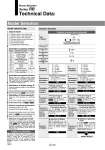
3-p1847-1869-rb_enĀ@Ā@Ā@3 / 24
10ēbĆ„ā…BOOKāŐÉyĀ[ÉWā…ąŕďģāĶā‹ā∑
Shock Absorber Series RB Technical Data: 2. Operating conditions 3. Specifications and operational instructions 4. Calculation of kinetic energy E1 5. Calculation of thrust energy E2 6. Calculation of corresponding mass of impacting object Me 7. Selection of RB0604 2. Operating conditions 3. Specifications and operational instructions 4. Calculation of kinetic energy E1 5. Calculation of thrust energy E2 6. Calculation of corresponding mass of impacting object Me 7. Selection of applicable model ūĎ Confirmation of specifications YES ūĎ Kinetic energy E1 E1 . 0.125 ūĎ Thrust energy E2 E2 . 0.157 ūĎ Corresponding mass of impacting object Me ūĎ Selection of RB0604 YES Me . 2.3 1. Type of impact Collision speed (1) É“ Kinetic energy E1 Thrust energy E2 Absorbed energy E Corresponding (2) mass of impacting object Me Cylinder stroke at load (Horizontal) É“ F1ĀES E1 + E2 ūĎ Confirmation of specifications YES ūĎ Kinetic energy E1 E1 . 2.3 J ūĎ Thrust energy E2 E2 . 9.4 J ūĎ Corresponding mass of impacting object Me ūĎ Selection of applicable model YES Select RB2015 Me . 260 kg Model Selection m = 1 kg É“ = 0.5 m/s d = 10 mm p = 0.5 MPa n = 30 cycle/min t = 25 ĀčC m = 50 kg É“ = 0.3 m/s d = 40 mm p = 0.5 MPa n = 20 cycle/min t = 25 ĀčC .ĀEmĀEÉ“2 12 .2 ĀEE É“2 RB0604 satisfies Me = 2.3 < 3 kg (Max. corresponding mass of impacting object). Ultimately, it will result in an operating frequency of 30 < 80, without causing a problem. Use the Formula ĀgAbsorbed energy E = E1 + E2 = 0.282Āh to calculate Me. Substitute 0.282 for E and 0.5 for É“. Model Selection Step Selection Example 1. Type of impact 2. Enumeration of operating conditions 3. Specifications and operational instructions 4. Calculation of kinetic energy E1 5. Calculation of thrust energy E2 6. Calculation of corresponding mass of impacting object Me Cylinder stroke at load (Horizontal) Cylinder stroke at load (Downward) Cylinder stroke at load (Upward) Conveyor stroke at load (Horizontal) Free horizontal impact Free dropping impact Rotating impact (With torque) Symbol mÉ“ hÉ÷ R dp F Tn tÉ Operating condition Impacting object mass Collision speed Dropping height Angle speed Distance between axis of cylinder and impact point Bore size Cylinder operating pressure Thrust Torque Operation cycle Ambient temperature Friction coefficient Unit kg m / sec m rad/sec m mm MPa N N ĀE m cycle / min ĀčC . Ensure that the collision speed, thrust, operation cycle, the ambient temperature and atmosphere fall within the specifications. .Be aware of the min. installation radius in the case of rotating impacts. Using the equation suitable for the classification of impact. Select any shock absorber as a provisional model. Absorbed energy E = E1 + E2 Corresponding mass of impacting object Me = .2 ĀEE É“2 É“ ĀEĀEĀE 0.3 < 5 (max.) t ĀEĀEĀE .10 (min.) < 25 < 80 (max.) F ĀEĀEĀE F1 ĀEĀEĀE628 < 1961 (max.) É“ ĀEĀEĀE 0.5 < 1.0 (max.) t ĀEĀEĀE .10 (min.) < 25 < 80 (max.) F ĀEĀEĀE F1 ĀEĀEĀE 39.3 < Use Formula to calculate E1. Substitute 50 for m and 0.3 for É“. Use Formula to calculate E1. Substitute 1.0 for m and 0.5 for É“. Use the formula ĀgAbsorbed energy E = E1 + E2 = 2.3 + 9.4 = 11.7 JĀh to calculate Me. Substitute 11.7 J for E and 0.3 for É“. According to Data D , the tentatively selected RB2015 satisfies Me = 260 kg < 400 kg at É“ = 0.3. Ultimately, it will result in an operating frequency of nĀEĀEĀE20 < 25, without causing a problem. Substitute both absorbed energy E and collision speed É“ for Data A in order to calculate the corresponding mass of the impacting object Me. Provisionally select a model RB2015 and make the use of Data B . According to d = 40, E2 is obtained. Provisionally select a model RB0604 and make the use of Data B at left. According to d = In the case of thrust energy of cylinder E1, 10, E2 is obtained. substitute respective figures for Data B or Data C . Cylinder Load Shock absorber In the case of cylinder stroke at load and free horizontal impact, substitute respective figures for Data A in order to calculate E1. 7. Selection of applicable model In order for the shock absorbers to operate accurately for long hours, it is necessary to select a model that is well-suited to your operating conditions. If the impact energy is smaller than 5% of the maximum energy absorption, select a model that is one class smaller. Caution on Selection Taking into consideration the corresponding mass of the impacting object Me, calculated using Data D and collision speed É“, check provisional model compatibility with the condition of application. If this is satisfactory, then the said provisional model will be the applicable one. 1848